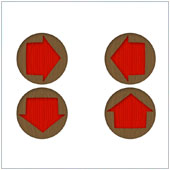
Below is an overview of how to adjust the margins of your Microsoft Word documents.
Why should I worry about margins?
If you are trying to create a document that will be printed, or are looking to make a document look as professional as possible, you will need to know about margins. In general, they are often the key to creating clean and readable content, due to the fact that they set how much white space surrounds each page and document.
The seven different margins
In Word 2010 and 2013, you have seven different styles of margin to choose from:
- Normal – The default setting for Word 2010. Margins are set at 1 inch (1″) at the top, bottom, left, and right. This is adequate for most printing and online needs, and can be especially useful for stapled or double-sided documents.
- Narrow – Has margins that are half that of the Normal setting (0.5″ of white space at the top, bottom, left and right of the document). This can be ideal for content-heavy documents that need to be fitted onto one page, or internal documents that don’t need a letterhead, or headers and footers.
- Moderate – Has the same 1″ top and bottom margins as the Normal style, but the left and right margins are 0.75 inches. This looks good for internal reports that are not being bound, and is best used for documents that won’t be printed.
- Wide – With the same top and bottom margins as the Normal layout, this style has wider left and right margins at 2 inches. A good use for this margin is if you are printing a report or document that will be bound.
- Mirrored – This margin setting is ideal for documents that will be published in the style of a book, or will be folded vertically. Margins are 1 inch at the top and bottom; 1.25 inches on the inside seam and 1 inch on the outside.
- Office 2003 Default – Because many older printers were limited by the length of their ribbon and couldn’t print documents with narrow margins, Office 2003 had default margins of 1 inch at the top and bottom and 1.25 inches on the left and right. If you use older printers in your office, this is a good setting to use for your Word Documents.
- Custom Margins – You can also set your own margins. If you have a printer that can only print specific margins, then you can click this to create your own settings. Note that if you set a margin that is too narrow for the majority of printers, Word will flash a warning message to remind you.
Applying margins
Here is how you can apply or change the margins in Word 2010 and 2013 documents:
- Open the document you wish to modify.
- Click on Page Layout, located in the toolbar at the top of the screen.
- Click on the arrow beside Page Margins which is located in the Page Setup section.
- Select one of the pre-existing margins or customize your own.
- Select OK.
Viewing margins
There are a couple of different ways to view the margins you have set. The first is to look at the top and sides of your document. You should see a ruler below the options buttons, but above the actual document. The white area of the ruler is where the content will be and the grey area is the margin. If you don’t see the ruler press on the View menu bar and select Ruler. Try this when in print layout view, as this will give you an accurate picture of what your document will look like when printed.
If you would like Word to display dotted lines indicating the page margins, follow this procedure:
- Click File followed by Options.
- Select Advanced.
- Tick the box beside Show text boundaries under the Show document content section.
Be aware that the dotted margin lines will not show up on printed documents, and may not show up in all views.

